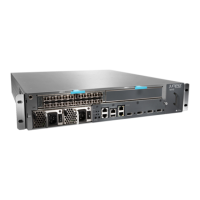Related
Documentation
Understanding Redundancy for the Routing Engine, Host Module, and Host Subsystem
on page 565
•
Determine Routing Engine Mastership by Checking the LEDs
Purpose To determine the Routing Engine mastership by checking the LEDs on either the craft
interface or the Routing Engine.
Action Physically check the LEDs on either the craft interface or the Routing Engine (depending
on which chassis the Routing Engine is installed). The Routing Engine that displays an
illuminated Master LED is the master Routing Engine.
Related
Documentation
Monitor the Routing Engine Status on page 178•
Log in To Backup Routing Engine If Graceful Switchover is Configured
If graceful switchover is configured, the command prompt will look as follows:
{backup}
user@host-re0>
{master}
user@host-re1>
With RE1 as master and RE0 as backup.
If you are logged in to the master Routing Engine, log in to the backup Routing Engine by
using the following command:
user@host> request routing-engine login other-routing-engine
user@host> request routing-engine login other-routing-engine
€Password: ########
{backup}
user@host-re0>
You are now logged in to the backup Routing Engine in slot RE0.
Related
Documentation
Understanding Redundancy for the Routing Engine, Host Module, and Host Subsystem
on page 565
•
Manually Configue Master and Backup Routing Engines
For routers with two Routing Engines, you can configure which Routing Engine is the
master and which is the backup. By default, the Routing Engine in slot 0 is the master
(RE0) and the one in slot 1 is the backup (RE1).
To modify the default configuration, include the routing-engine statement at the [edit
chassis redundancy] hierarchy level:
[edit chassis redundancy]
routing-engine slot-number (master | backup | disabled);
Copyright © 2012, Juniper Networks, Inc.578
M Series and T Series Routers Monitoring and Troubleshooting Guide

